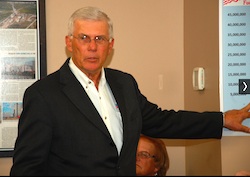Last week Patriot Renewable Fuels announced the news that the biofuels plant is making plans, and hopes to add, ICM’s Fiber Separation Technology as well as their Generation 1.5 cellulosic technology to their biorefinery facility located Annawan, Illinois. Patriot is one of the first ethanol plants in the country to adopt both technologies together. During 2014 FEW this week Gene  Griffith, co-founder and president of Patriot updated DomesticFuel on the project. It should be noted that this is just one of several major value-added projects Patriot has announced in less than a year making them one of, if not the most innovative ethanol plant/biorefinery in the U.S.
Griffith, co-founder and president of Patriot updated DomesticFuel on the project. It should be noted that this is just one of several major value-added projects Patriot has announced in less than a year making them one of, if not the most innovative ethanol plant/biorefinery in the U.S.
Griffith said they are pretty excited about the projects and after spending several months doing due-diligence on ICM’s technologies as well as other technologies, they felt that this was the right time to begin the project.
“If we get it implemented, we’ll be one of the earlier, maybe one of the earliest independent ethanol producers to this form of cellulosic ethanol, and we’re really excited about it,” said Griffith.
Griffith said being at FEW is a great networking opportunity because the the people Patriot works with are entrenched and have a lost of useful information and they are able to learn information they wouldn’t be able to generate on their own.
Last December, Patriot added another ICM platform, Select Milling Technology, and the Fiber Separation Technology builds upon this platform. “The Select Milling Technology is a separate mill that further processes the starch in the corn kernel as its ground before it goes into the fermentation process, explained Griffith. “The platforms we’re adding will be the Fiber Separation Technology which separates the fiber from the starch. Essentially, by removing the fiber from the starch, it improves our ethanol production efficiency so we get more ethanol from the corn,” explained Griffith.
Then he noted that they are able to take the fiber and do two-three things with it. One, they could add it back to the distiller’s grain (DDGs) and sell it has a high fiber form of distillers grain protein. Two, they could keep the fiber separate and sell a higher protein feed for a premium that is better for monogastric animals (such as pigs). The third option, which is what Patriot would like to do, is to ferment the fiber for additional ethanol.
 Presently Patriot is producing around 130 million gallons of ethanol per year and Griffith thinks they can produce another 10-12 percent ethanol production from the same kernel of corn. Griffith hopes that they can have all their permits by the end of the year and implement the two new technologies by 2015.
Presently Patriot is producing around 130 million gallons of ethanol per year and Griffith thinks they can produce another 10-12 percent ethanol production from the same kernel of corn. Griffith hopes that they can have all their permits by the end of the year and implement the two new technologies by 2015.
Griffith said many producers are doing similar things with different company’s technologies but they spent a lot of time with him learning about the technologies they implemented. He also said other producers will be watching their progress to help them decide if and when the technologies might be a good addition to their plants.
Learn more Patriot’s ethanol innovations by listening to Gene Griffith: Interview with Patriot's Gene Griffith




 sued a scathing 13-page response
sued a scathing 13-page response 


